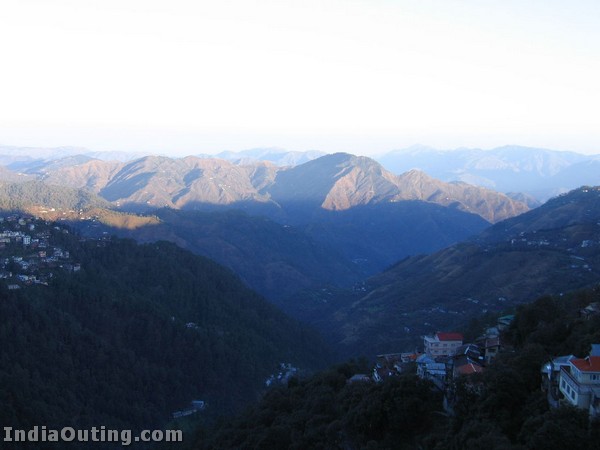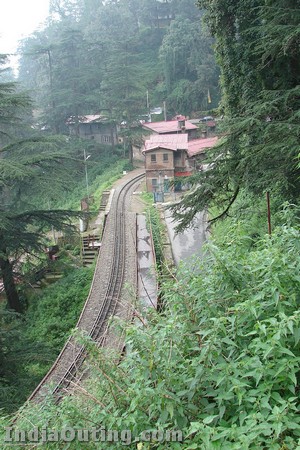Shimla pronunciation (Hindi: शिमला), originally called Simla, is the capital city of Himachal Pradesh. In 1864, Shimla was declared the summer capital of the erstwhile British Raj in India. A popular tourist destination, Shimla is often referred to as the “Queen of Hills” (a term coined by the British). Located in north-west Himalayas at an altitude of 2,130 metres (6,988 ft), the city of Shimla, draped in forests of pine, rhododendron, and oak, experiences pleasant summers and cold, snowy winters. The city is famous for its buildings styled in tudorbethan and neo-gothic architecture reminiscent of the colonial era. Shimla is connected to the city of Kalka by one of the longest narrow gauge railway routes still operating in India. Shimla is approximately 115 km (71.4 miles) from Chandigarh, the nearest major city, and 365 km (226.8 miles) from New Delhi, the national capital. The city is named after the goddess Shyamala Devi, an incarnation of the Hindu Goddess Kali.



History
Shimla was annexed by the British in 1819 after the Gurkha War. At that time it was known for the temple of Hindu Goddess Shyamala Devi. Scottish civil servant Charles Pratt Kennedy built the first British summer home in the town in 1822.
The Lord Amherst, Governor-General of Bengal from 1823 to 1828, set up a summer camp here in 1827, when there was but one cottage in the town, and only ‘half a dozen’ when he left that year. There were more than a hundred within ten years.
Shimla, or Simla as it was called until recently, caught the eye of Lord William Bentinck, the Governor-General of Bengal from 1828 (later of India, when the title was created in 1833) to 1835. In a letter to Colonel Churchill in 1832 he wrote
| “ | Simla is only four days march from Loodianah, is easy of access, and proves a very agreeable refuge from the burning plains of Hindoostaun | ” |
His successor, Sir John Lawrence, Viceroy (and Governor-General) of India, 1864–1869, decided to take the trouble of moving the administration twice a year between Delhi and a separate centre over 1,000 miles away, despite the fact that it was difficult to reach. Lord Lytton, Viceroy 1876 -1880 made efforts to plan the town from 1876, when he first stayed in a rented house Peterhof, but began plans for a Viceregal Lodge, later built on Observatory Hill. A fire cleared much of the area where the native Indian population lived (the “Upper Bazaar”), and the planning of the eastern end to become the centre of the European town forced these to live in the Middle and Lower Bazaars on the lower terraces descending the steep slopes from the Ridge. The Upper Bazaar was cleared for a Town Hall, with many facilities such as library and theatre, as well as offices – for police and military volunteers as well as municipal administration.


During the ‘Hot Weather’, Simla was also the Headquarters of the Commander-in-Chief of the Indian Army and many Departments of the Government, as well as being the summer capital of the regional Government of the Punjab. They were joined during the hot weather by many of the British wives and daughters of the men who remained in the plains. Together these formed Simla Society, which, according to Charles Allen, “was as close as British India ever came to having an upper crust.” This may have been helped by the fact that it was very expensive, having an ideal climate and thus being desirable, as well as having limited accommodation. British soldiers, merchants, and civil servants moved here each year to escape from the heat during summer in the Indo-Gangetic plain. The presence of many bachelors and unattached men, as well as the many women passing the hot weather there, gave Simla a reputation for adultery, and at least gossip about adultery: as Rudyard Kipling’, said in a letter cited by Allen, it had a reputation for “frivolity, gossip and intrigue”.
The Kalka-Shimla railway line, constructed in 1906, added to Shimla’s accessibility and popularity. The railway route from Kalka to Shimla has more than 806 Bridges and 103 tunnels was touted as an engineering feat and came to be known as the “British Jewel of the Orient”. In addition, Shimla was also the capital of the undivided state of Punjab in 1871 and remained so until the construction of the new city of Chandigarh (the present-day capital of Punjab). Upon the formation of the state of Himachal Pradesh in 1971, Shimla was named its capital. Pre-independence structures still dot Shimla; buildings such as the Viceregal Lodge, Auckland House, Gorton Castle, Peterhoff house, and Gaiety Theatre are reminders of British rule in India. British Simla extended about a mile and a half along the ridge between Jakhoo Hill and Prospect Hill. The central spine was The Mall, which ran along the length of the ridge, with a Mall Extension southwards, closed to all carriages except those of the Viceroy and his wife.


Transport
Local transport in Shimla is by bus or private vehicles. Buses ply frequently on the circular road surrounding the city center. Tourist taxis are also an option for out of town trips. Locals typically traverse the city on foot. Private vehicles are prohibited on the mall, ridge, and nearby markets. Due to narrow roads and steep slopes, the auto rickshaws common in other Indian cities are largely absent.
Shimla is well-connected by road and rail. The National Highway NH-22 connects Shimla to the nearest big city of Chandigarh. The scenic Kalka Shimla Railway, a narrow gauge track, is listed in the Guinness Book of Records for the steepest rise in altitude in a distance of 96 km. 



Geography
Shimla is located in the north-western ranges of the Himalayas. At an average altitude of 2397.59 meters (7866.10 ft) above mean sea level, the city is spread on a ridge and its seven spurs. The city stretches nearly 9.2 km from east to west. The highest point in Shimla, at 2454 meters (8051 ft), is the Jakhoo hill.
Climate
The climate in Shimla is predominantly cold during winters, and moderately warm during summers. The temperatures range from 3.95 °C (39.11 °F) to 32.95 °C (91.31 °F) over the year. The average temperature during summer is between 14 °C and 20 °C, and between -7 °C and 10 °C in winter.


Places Of Interest
- The Mall: The Mall is the main shopping centre of Shimla. It also has many restaurants, clubs, banks, bars, Post Offices and tourist offices. The Gaiety Theatre is also situated there. People walk up and down the Mall slowly, stopping to gossip, as it is the main meeting place for everyone. The Ridge and Scandal point are the two main meeting points at the Mall.
- Christ Church: Situated on the Ridge, Christ Church is the second oldest church in Northern India. It has a very majestic appearance and inside there are stained glass windows which represent faith, hope, charity, fortitude, patience and humility. Christ Church is a place all visitors should spend some time in.
- Jakhu Hill: 2 km from Shimla, at a height of 8000 ft, Jakhu Hill is the highest peak and offers a beautiful view of the town and of the snow-covered Himalayas. At the top of the Hill, is an old temple of Hanuman, which is also the home of countless playful monkeys waiting to be fed by all visitors.
- Shimla State Museum: The Museum, which was opened in 1974, has tried to project hill-out and the cultural wealth of the state. There is a collection of miniature Pahari paintings, sculptures, bronzes wood-carvings and also costumes, textiles and jewellery of the region.
- Indian Institute of Advanced Study: This institute is housed in the Viceregal Lodge, which was built in 1884-88 during the British times. It has spacious gardens and is ringed by beautiful pine trees. All is calm and serene just the right atmosphere for a student of literature or politics.
- Summer Hill: Situated at a distance of 5 km from the Ridge is the lovely township of Summer Hill at a height of 6,500 ft on the Shimla-Kalka railway line. Mahatma Gandhi lived in these quiet surroundings during his visits to Shimla. Himachal Pradesh University is situated here.


- Annandale: Developed as the playground of Shimla, Annandale is 2-4 km from the Ridge at a height of 6,117 ft. It is a favourite spot for cricket, picnics and the princely game of polo.
- Tara Devi: 11 km from the Shimla bus-stand. Tara Devi has a temple dedicated to the goddess of stars on top of the hill. There is a military Dairy Town here as well as the headquarters of Bharat Scouts and Guides. At a height of 6,070 ft, Tara Devi is an ideal place for a person wanting peace and some rest.
- Sankat Mochan: A popular Hanuman temple is located here. We get an excellent view of Shimla from the temple. It can be reached by car or on foot.
- Junga: Junga is a Tehsil in the picturesque district of Shimla, Himachal Pradesh. Its original name (with diacritics) is Jūnga. Located at a distance of 26 km from Shimla this place is known for a palace and museum of erstwhile Junga Princely state and its scenic beauty and the numerous easy to hard treks it offers. Junga is surrounded by green hills with snow capped mountains and has a forest cover of Kail, Deodar, Pine, cedar, Oak Rhododendro, Cheel, Ban and other trees.
- Mashobra: 13 km away from Shimla, Mashobra has several excellent picnic spots. Mashobra is the site of the annual Sipi fair in June. The nearest rest house is at Carignano which is 3 km from Mashobra, and is a beautiful holiday resort.

- Kufri : 16 km from Shimla at a height of 8,600 ft, Kufri is the winter sports capital. During winter, visitors have the facility for skiing. The skiing season is at its best during January and February. Equipment for sking is available from HPTDC winter sports club at Kufri. Apart from skiing, Kufri is a lovely picnic spot with a beautiful view of the hills around and the snowy peaks. There is also a zoo that delights children.
- Chail: Chail is a little mountainous heaven 45 km from Shimla. It was the summer capital of the Maharaja of Patiala before Independence. The forests near Chail have many species of birds and deer. Chail is known for its cricket pitch, which is the highest cricket ground in the world.
- Arki: 40 km away from Shimla, Arki is a town and a Nagar panchayat in Solan district in the state of Himachal Pradesh, India. The town is notable for its fort built in late 18th century when Arki was the capital of hill state of Baghal. The Arki Fort is a converted hotel and lovely to visit.




